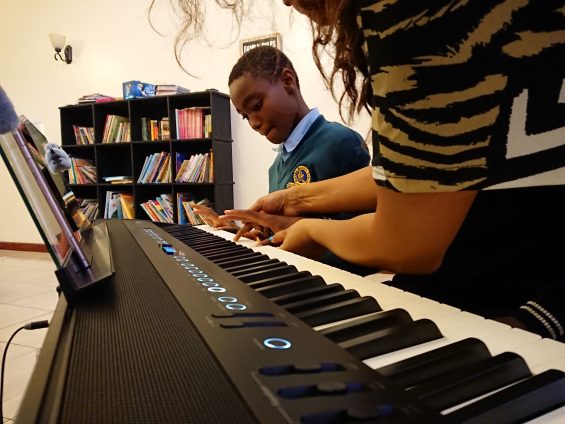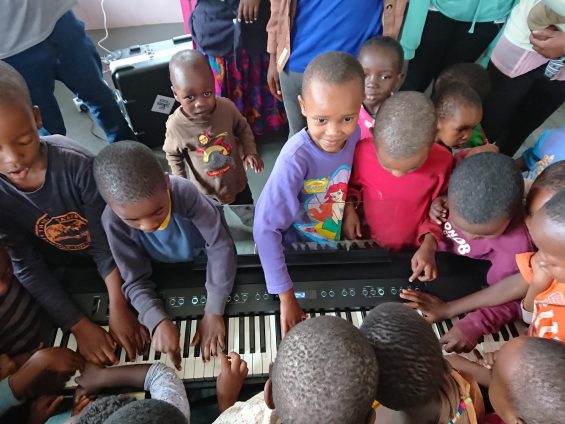This post is sponsored by Corning® Gorilla® Glass
“So many people come and say they’re going to help but they never come back.” These words from six years ago linger in my subconscious since first traveling to Haiti in 2012, though it’s not guilt that brings me back year after year. The numerous stamps in my passport serve as physical evidence of trips to Haiti where emotional connections formed to people and places draw me back to a country that I truly love. It’s a place that, through unforgettable experiences, has contributed to numerous lessons about conscious giving to change me for the better.

Lessons can always be learned through travel but it’s in the toughest places that we learn the most about ourselves. It’s one thing to go to a place and say you’ve made a difference. It’s another to return year after year and with each subsequent trip, develop a deeper understanding of the people, culture, issues, and history.
By traveling around the world with a piano, concert pianist Ambre Hammond shares her passion for music with children through her Girl Piano Truck project.
Watching Ambre play for communities in Tanzania reminded me of the importance of conscious giving and the many things I’ve learned through repeated trips to Haiti.

Over the years I’ve learned many lessons about conscious giving. It’s one thing to help, it’s another to do it thoughtfully so the benefits last far beyond your visit. There are best practices and strategies to be mindful of to ensure your family is giving back in the most meaningful ways. Sharing your passion, connecting through shared experiences, and being mindful about the nonprofit organizations you support are important elements of conscious giving.
Whether traveling abroad or supporting organizations whose initiatives reach around the globe from home, here are some ways you and your family can make sure you are practicing conscious giving.
3 Lessons Learned About Conscious Giving from My 6 Years in Haiti

Share Your Passion and Skills

Deep within each parent is a fire that burns for our kids. The love we have for them that can never be extinguished and fuels us in our attempts to raise good humans. This passion compels us to use our knowledge and expertise to make the world a better place through everyday actions, advocating for change on a state, local, or federal level, or taking on global issues on behalf of children everywhere. As our kids see our passion turn into action and hear about the issues we’re advocating for, they’re likely to stand by our side and want to get involved too.

Leticia Barr and her daughter, Emily, meet Haiti’s Minister of Tourism during Carnival 2015 © 2015, Leticia Barr All Rights Reserved
Just as Ambre Hammond shares her passion of music with children in Tanzania, each of us has skills we can share with organizations close to home and around the world. Our knowledge and expertise is incredibly valuable when we pass our skills along to others. By doing so, we build capacity by strengthening the skills, competencies, and abilities of people in developing countries.

Church mission trips, U.S. based organizations with long histories of working in the country, and organizations within the country can serve as entry points for volunteer opportunities, or voluntourism. Voluntourism can be controversial because some believe it hurts more than it helps, but do your research and look for these three things when choosing a program:
- Who runs the program? What is their history of working in the country? Established programs in the country are more likely to have sustainable programs in place. It’s also a good idea to check Charity Navigator, an independent charity evaluator that rates thousands of organizations on the true impact of their philanthropic efforts.
- What volunteer opportunities are there? Is there a chance to use what I know to teach community members a skill? Ensure you’ll be teaching community members skills that will build capacity and empower them.
- What have other volunteers said about their experiences? Yelp reviews from past volunteers can be helpful in providing insight about your experience.
Connect Through Shared Experiences

Once you’ve selected an organization to volunteer with, know that you’ll be viewed with skepticism when you arrive. Ambre’s experience of being eyed with suspicion is similar to what I’ve encountered in Haiti. Haitians are used to “blan,” or white people, coming as aid workers and missionaries but a Chinese American woman such as myself invites the same intrigue and suspicion as Ambre during her trip to Tanzania. Breaking down barriers to form connections involves finding a common ground that can be shared despite language and culture barriers.

I’ve asked if I could sit with artists in Haiti to learn their craft. This allowed me to connect with them through a shared experience. Papier mâché, embroidery artists, and metalworkers are experts at their crafts who take pride in sharing their work with me. Sometimes the brave will even let me work alongside them even though my skills are crude compared to their refined ones. Others, like Aileen (below), are thrilled to sit down with my daughter, Emily, to teach her embroidery during our mother-daughter trip to Haiti.

Emily learns how to make embroidered cards at OFDALAF © 2015, Leticia Barr All Rights Reserved
Just as art serves as a connection between me and artisans in Haiti, music forms a bond between Ambre and the people she meets through Girl Piano Truck. By taking a piano to schools and orphanages in remote and disadvantaged communities around the world, Ambre shares the universal language of music.

Even though they may have never seen or heard a piano before, her ability to learn to play songs they commonly sing and give them the experience of playing allows her to form a bond with the children. Common experiences built around personal passion allow us to form powerful connections with each other and breaks down initial barriers.
Ensure Sustainability and Maintain Hope

Distinguishing between help that satisfies our personal need to feel good versus the true needs of those you’re assisting is important because communities don’t always need what we think they do. Sharing skills and connecting through shared experiences are helpful and satisfy our personal need to feel good about what we’re doing in order to make sure we’re making a difference, our contributions need to be part of a bigger puzzle that can be sustained.

So many times I’ve left Haiti wondering what will happen next. What will the artisans I’ve worked with carry forward and was my work with them impactful? It’s always a question in the back of my mind upon departure and sometimes I’ve returned frustrated that not more progress was made and other times I’ve been pleasantly surprised.
As Ambre gifted Kelvin and the children’s home her piano, I wondered what the future would hold for this young motivated musician. The piano and assurance of lessons are a sustainable way to ensure the gift is used and his talents develop. I’m hopeful that one day Ambre will return to play a duet with Kelvin and he will have inspired other children to learn to play too.

Get inspired to travel to countries around the world by watching Ambre Hammond and other tough individuals whose work is featured through the Corning® Gorilla® Glass Incredibly Tough series.
To learn more about Corning® Gorilla® Glass:
- Visit IncrediblyTough.com and the Corning® Gorilla® Glass website
- Watch more incredibly tough individuals doing incredibly tough things in their everyday lives on the Corning® Gorilla® Glass Incredibly Tough YouTube playlist
- Follow Corning® Gorilla® Glass on Twitter
- Like Corning® Gorilla® Glass on Facebook
- Like Corning® Gorilla® Glass on Instagram
- Read my past posts about Corning® Gorilla® Glass
This post is sponsored as part of my work with Corning Incorporated, all opinions are my own.


